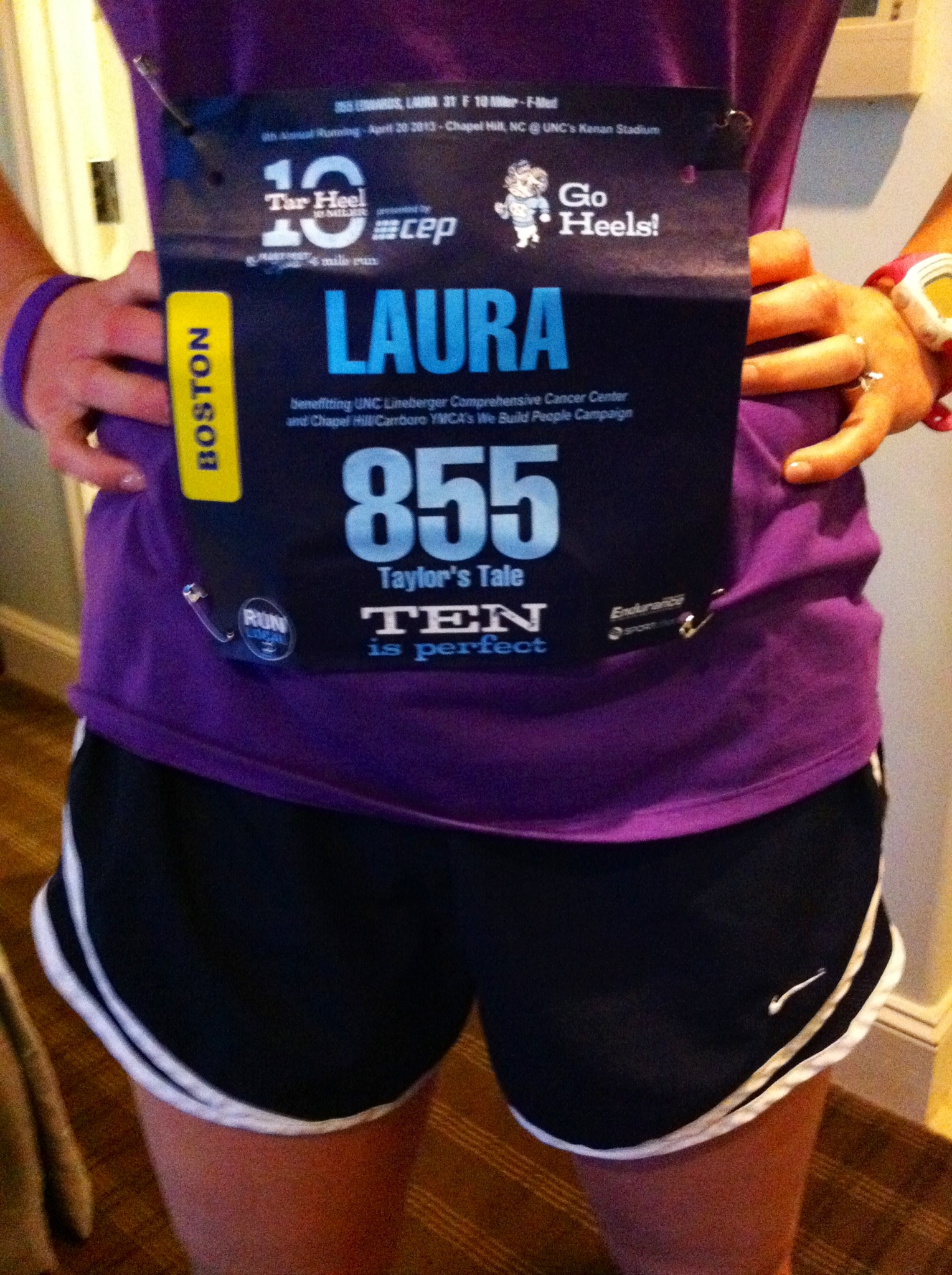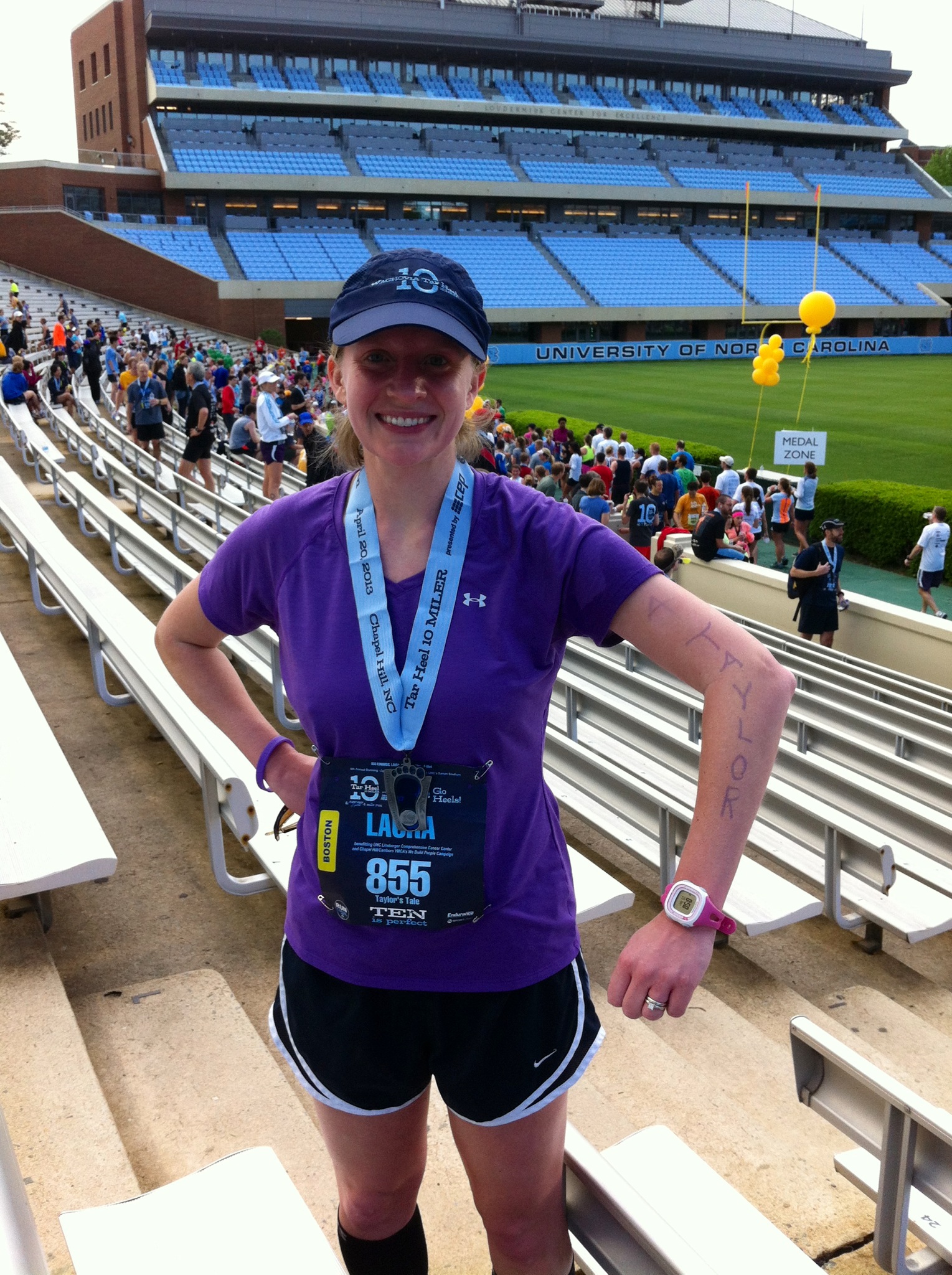 Yesterday morning, I woke with the sun to run the Tar Heel 10 Miler in my little sister’s honor for the fourth consecutive year.
Yesterday morning, I woke with the sun to run the Tar Heel 10 Miler in my little sister’s honor for the fourth consecutive year.
I’ve already collected four race medals for Taylor in 2013, but this one is special. The Tar Heel 10 Miler was just the second competitive race I ever entered; I paid the entry fee for the April 2010 edition not long after watching my sister – blind and suffering from a rare, fatal brain disease – jog across the finish line of Charlotte’s Jingle Jog and Girls on the Run 5Ks on one end of a running buddy’s guiding rope and the wings of her own courage.
The Girls on the Run 5K, staged on a sun-drenched, happy day in May 2009, was Taylor’s second race. It was also her last.
Batten disease has stolen so much from Taylor since it crept into her life that the word “unfair” doesn’t begin to do the job. The ability to run is a precious gift that too many of us take for granted, but my sister has lost many more valuable things.
I wish I could make Batten disease go away. I wish I could work magic – go back in time and give Taylor two good copies of the gene that causes Batten disease or even one good copy (which would make her a healthy carrier, like me). But I can’t.
So I share her story in my own words – both spoken and written. I help support the people who have the knowledge to find answers for children like her – people like Steven Gray, PhD of UNC’s Gene Therapy Center, to which Taylor’s Tale awarded a two-year grant earlier this year.
And I run.
On Saturday morning, I followed the brick sidewalks to the football stadium nestled in the trees on the same campus where Dr. Gray works his magic for children like my sister and where I earned my undergraduate degree. I lined up on the track at field level with 3,253 other runners. When the gun sounded at 7:30, I found an opening in the crowd and sprinted through the stadium tunnel and into my 10-mile mind game.
The Tar Heel 10 Miler, set mostly on the gorgeous UNC campus, has some tough sections, but none come close to Laurel Hill, the 200-foot vertical gain over the course of about one mile at the 8.5-mile mark. It’s so difficult that the race organizers place separate timing mats at the bottom and top and hand out special awards just for the hill, and many self-respecting athletes speed-walk it. I’ve never walked, but I’ve come close.
 I went into Saturday’s race riding a streak of four straight personal records (PRs) for the half marathon, 10 miler, 5K and 10K that started at the Thunder Road Half Marathon in Charlotte last November. Even though I’d beaten my previous 10 miler record by two minutes just two months earlier at a race in Charlotte, I was determined to beat it again.
I went into Saturday’s race riding a streak of four straight personal records (PRs) for the half marathon, 10 miler, 5K and 10K that started at the Thunder Road Half Marathon in Charlotte last November. Even though I’d beaten my previous 10 miler record by two minutes just two months earlier at a race in Charlotte, I was determined to beat it again.
But when I reached the first Laurel Hill timing mat, things didn’t look good. My quadriceps burned, and worse – I felt winded. I never get winded. I was riding a 7:45/mile pace through the first 8.5 miles, and it’d taken a lot out of me.
As I started the climb, a voice in my head told me it wasn’t my day. I shouldn’t have eaten the sweet potato fries at Top of the Hill the previous night. I shouldn’t have stayed up till midnight watching the Boston Marathon bombing coverage. As I wheezed my way up those 200 vertical feet, I told myself that WHEN I cross the finish line isn’t important to Taylor (which is true). As my Garmin watch beeped its “Behind Pace” beep, again and again…I began to write my post-Tar Heel 10 Miler blog post in my head. I called it, “I Lost My PR and Found My Truth on Laurel Hill.” I talked to myself over my wheezing. “You can do this,” I breathed. “Forget the stupid PR. Just RUN.”
But then, something happened. My quads loosened. The tightness in my chest melted away. The houses perched at the top of Laurel Hill came into view.
For most of the race, I used my Garmin as my guide. I ran for Taylor, but I ran more for myself.
The moment I understood that is when I left the Ghost of Laurel Hill behind.
It seemed like just moments later that the stadium reappeared. I sprinted into the tunnel, down the track and across the finish line.
When I did, the clock read 1:20:48.
I beat my PR for 10 miles by almost two full minutes and ran the Tar Heel 10 Miler four minutes faster than ever before. I finished in the top 16 percent of 3,253 runners. And when I crossed that finish line, I felt as if I could fly.
Almost like I had wings.

